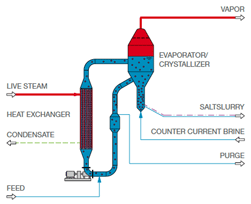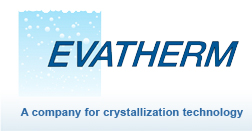The MSMPR (Mixed Suspension, Mixed Products Removal) and the MSCPR (Mixed Suspension Classified Products Removal) are the classical devices to crystallize salts.
As the name implies, the liquor in a forced-circulation evaporator is pumped through the tubes to minimize tube scaling or salting when precipitates are formed during evaporation.
Slurry is pumped from the bottom cone of the vapour body through the tubes of the heat exchanger, where heat is added, and back into the vapour body where evaporation occurs. Sufficient slurry height is maintained above the heat exchanger to suppress boiling in the inlet and prevent surface boiling on the tube surface. This is necessary to preclude salt precipitation on tubes. A high circulation rate is provided for adequate tube velocity to achieve good heat transfer. Therefore, lower slurry temperature rises are assured which minimize supersaturation of the solution. A sufficient quantity of salt crystals is suspended in the circulating system to provide seed crystals in the boiling zone for salt growth. Adherence to these basic principles of crystallization results in coarse crystals and minimal wall and tube salting.
The circulating pumps operate at low speeds, which minimize mechanical attrition of the salt crystals.
EVATHERM radial inlet nozzle provides excellent mixing of slurry the vapour body. Secondary vertical currents are also generated, mixing body slurry with the hotter slurry entering the vapour body to reduce the degrees of flash.
The elutriating leg is a device for thickening the slurry it receives from the vapour body and for salt crystal washing and classification. Salt crystals are fluidized and washed in the leg with a portion of the feed liquor which enters the bottom cone. Smaller crystals are washed backed into the vapour body for additional growth and the larger crystals are discharged from a connection near the bottom o the leg.



